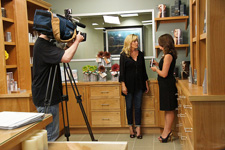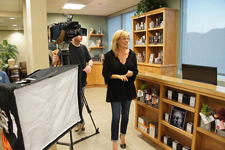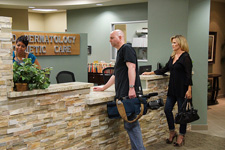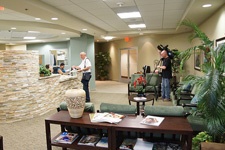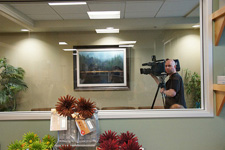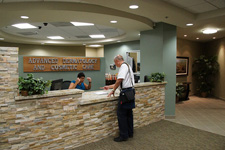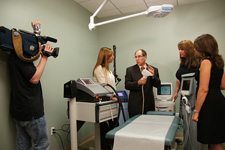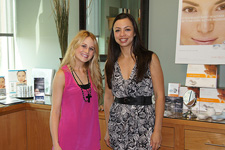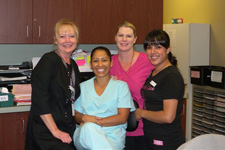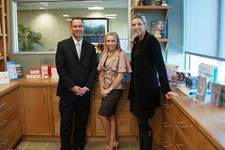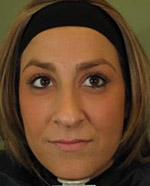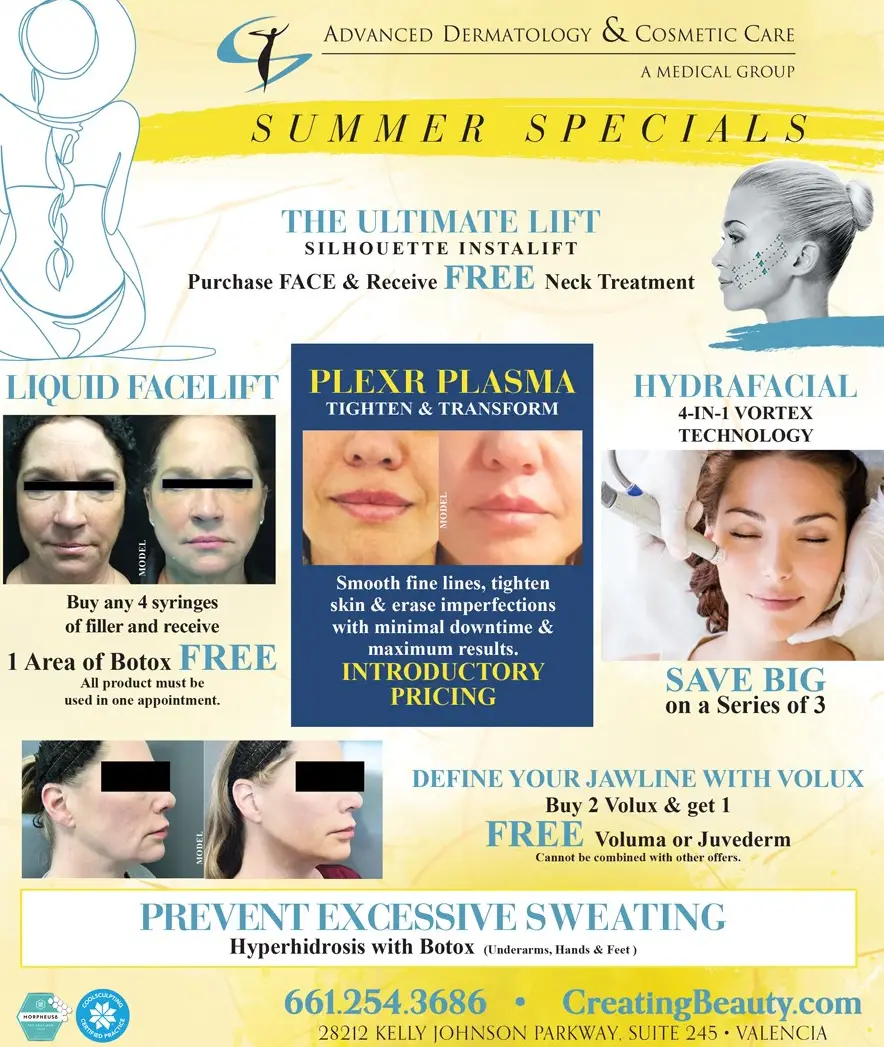Archive for October, 2011
Day of Beauty Photos
Thank you to everyone that made our “Day of Beauty” a success. Here are some photos that we would like to share with you from the event.
Hyperhidrosis: Don’t sweat it!
By Bernard I Raskin, M.D.
By now everyone has heard of the cosmetic benefits of Botox® for treating wrinkles. Now there is another great use for this product. Botox® is also used for treating a condition called hyperhidrosis.
Hyperhidrosis is the over production of sweat typically on the palms, feet, or axilla (underarms). The human body produces sweat to regulate body temperature, and a certain amount of sweat is normal. People diagnosed with hyperhidrosis sweat in excess of that required to cool the body.
Botox® treatment helps control hyperhidrosis by temporarily blocking the chemical signals from the nerves that stimulate the sweat glands.
Your dermatologist can diagnose excessive sweating that is not being effectively managed with topical agents. Be prepared to tell your dermatologist about your medical history, family history, and when you first noticed your excessive underarm sweating. You may be asked to answer a self-assessment questionnaire regarding the extent to which excessive underarm sweating affects your daily activities. Once a diagnosis has been made, your dermatologist will discuss the appropriate treatment options with you.
The procedure itself takes approximately 30 minutes. The provider will ask the patient which areas bother them to determine how far beyond the hair bearing area to inject. The injections are scattered approximately every 2 square centimeters to cover the entire area of the axillae. It is also possible to perform an iodine starch test prior to injections to ascertain which areas need to be injected.
The iodine starch solution is applied to the affected area and then covered with starch. The areas that produce sweat will turn black, telling the physician which areas to inject.
You should notice a significant reduction in underarm sweating within 4 weeks of your first treatment. If you are still sweating, there is a possibility that some sweat glands may have been missed, and you may continue to experience some sweating from the untreated areas. If you do not see a significant reduction in sweating, you should contact your healthcare provider and request a follow-up consultation.
Typically patients treated with Botox® for hypohydrosis see improvement in under arm sweating for up to 6 months. It is not a cure; your symptoms will return gradually, and you will know when the time is right for another treatment. Your healthcare provider will recommend a treatment strategy to ensure that you receive the best possible results.
For more information please contact Advanced Dermatology & Cosmetic Care at 661.254.3686 or visit www.CreatingBeauty.com.
Great combinations
By Bernard I. Raskin, M.D.
Fred Astaire & Ginger Rogers, Milk & Cookies, Gin & Tonic, all great combinations. When we hear these words together their impact is much greater than individually. The same goes for treatments. Many people think that one laser “does it all”, but in reality it’s a combination that gives that “wow” result. As we all age several things happen. Our skin’s surface becomes weathered, blotchy, spotted, rough and crepe. That is what proper skincare products, peels, microdermabrasion, or if more severe, laser resurfacing can treat. As we continue to age we start to lose collagen, fat, and even bone. Our face starts to look more angular, drawn, and starts to sag. That is when we add volume with injectable fillers. Lastly the skin starts to stretch and that is where surgery or the less invasive Thermage comes into the picture. To age in the most inconspicuous way, you should start early with proper skincare, then add things in slowly as needed. Those people that look fabulous and appear to be aging really well are the ones who are probably doing a little something. Maybe a peel or IPL every couple of months. A little Botox or Dysport about 3 times a year. Then adding some subtle fillers usually starting in their late 30’s. No one would ever guess any of these things are being done, and that’s the point, Very Natural. So it’s not just one treatment that does it all, it’s the combination that gives the most natural, youthful you that you can be.
For more information please contact Advanced Dermatology & Cosmetic Care at 661.254.3686 or visit www.CreatingBeauty.com.
Can skincare products really help against aging?
Skincare companies are constantly telling us about their latest “wonder cream” or “new” ingredient, but how can you tell if they work. First, let me tell you about how products are tested. For claims about increasing moisture, often times participants are told to discontinue all skincare products for several weeks before the trial starts. This is to make sure no prior product will influence the test. But in fact, since NO previous product was used, by simply putting almost anything on will increase moisture. Companies will perform many types of tests on their products, but may choose to only highlight one or two making it seem the latest and greatest, when in fact their product may be inferior on all of the other tests. So what is a consumer to do? If you don’t want to have to go thru pages and pages of research and studies yourself, go to someone who does. Does the place where you purchase your skincare have a person specifically trained in skincare? Do they have access to the latest clinical data? How often do they attend conferences/seminars/training? (and not just from ONE skincare line)
So, can products really help against aging? Yes, the right ones can. A common question in my practice is if a specific product is good, example, “Is Lubriderm or Cetaphil a good moisturizer?” and my answer would be: as a moisturizer, yes; but as an anti ager, no. So what does that mean? It means that moisturizer alone is only a small piece of the puzzle. It will provide hydration, period. But to really fight the hands of time you need ingredients such as Retinol (helps stimulate collagen), Vitamins C&E fight free radicals by preventing new damage, an exfoliant to help aid in cell renewal (as we age this process slows and can make skin drier/wrinklier/coarser), sunscreen with Zinc, there are others and products are chosen based on a specific person’s needs. In a nutshell Retinol tells our skin to make new collagen, but we need Vitamin C to make that new collagen. New studies have shown that fat soluble C is better penetrating that water soluble, so here is an example why where you buy your skincare from makes a difference. At our office we are constantly approached from companies that want us to sell their products. We do a thorough analysis and if they pass our critical judgment, we will bring them in. So if you are one of those people that just use a moisturizer, that’s OK, but you can be doing much better and it will show on you face.
For more information contact Advanced Dermatology & Cosmetic Care at 661.254.3686 or visit www.CreatingBeauty.com
Botox vs Dysport (you now have a choice)
The word Botox is now a part of our common vocabulary, but just like Kleenex and Xerox, it is a brand name. And now in the USA, there is finally some competition in the “Neurotoxin” category. The product is called Dysport. Here are some basic differences:
Botox and Dysport have similar mechanisms of action (blocking nerve impulses).
Dysport is no stronger nor more effective than Botox and vice-versa.
The duration of effect (how long it lasts) is similar. The Dysport literature will state it lasts up to four months, Botox says three to four months.
One unit of Botox does not equal one unit of Dysport, so be careful when looking at unit pricing. In our office we price by the area, so we can get proper correction on all patients for a set fee.
In clinical studies, author’s noted that Dysport “spreads more” during injection. This can be a good and bad thing. In large areas, such as the forehead or armpits, fewer injections would be needed due to the spreading. Meaning less discomfort, swelling and bruising. It could be bad in that unless the injector is experienced with a good understanding of more complex musculature (around the eyes, between the eyebrows), the Dysport could spread into unwanted areas causing untoward side effects (droopy eyebrows).
We use both products in our office. What we have seen so far:
Many patients feel Dysport starts working sooner. Approximately 2-3 days after injection vs. about 5-7 days with Botox.
We have not seen any “spreading” problems with Dysport, but we are very careful and choosy about placement.
As with all new products and treatments, we are constantly searching out the best. Ultimately I think we will continue to use both products. As a matter of fact, we sometimes use both products on the same patient because of the slight nuances.
For more information, contact Advanced Dermatology & Cosmetic Care at 661-254-3686 or visit www.CreatingBeauty.com.
Antioxidants: What you should know
By Bernard I. Raskin, M.D.
Ultraviolet light causes many forms of damage to your skin cells. The ultraviolet light rays cause breaks in your DNA which often results in cancer years later. Ultraviolet light smashes into cell proteins causing atomic particles to shoot off at high speeds and smash into other proteins and break them apart into other particles that continue to cause damage. So even a small amount of ultraviolet light can result in a large amount of damage to the proteins your cells need for normal function—kind of like an earthquake causing a tsunami.
Antioxidants are chemicals that protect cells by neutralizing external forces (such as damage from the sun or pollution) and internal factors (for example ingested toxins). They work by capturing the high speed particles before those particles can smash into important structures, almost like a hockey net stopping a speeding hockey puck. There are many antioxidants available but some of the strongest antioxidants are Vitamins C, E, green tea, and Ferulic Acid. Antioxidants for your skin work best when applied directly to the skin rather than as dietary supplements. These agents assist in skin repair and the strengthening of blood vessels.
Vitamin C is also known as ascorbic acid and its active form is called L- Ascorbate. Vitamin C stimulates collagen production, assists to break up pigmentation and contributes to faster wound healing. Vitamin C also helps reduce skin redness. Vitamin C, combined with UVA/UVB sunscreen or sunblock, gives superior sun protection that is better than either preparation alone.
Vitamin E is also known as Alpha-tocopherol. Vitamin E provides significant protection against skin redness and protects skin cells from self destructing due to sunburn and the oxidative effects of UV exposure.
Green tea antioxidants are known as EGCG or by its spelling bee name of epigallocatechin gallate. Studies suggest that EGCG have anti-inflammatory and anti-cancer properties that may help prevent the onset and growth of skin tumors. Topical application of EGCG importantly may prevent UV induced immunosuppression and precancerous cell changes after UV exposure. EGCG is respected for its ability to reduce, eliminate and neutralize free radicals and the damage they cause. Many scientific studies and scholarly articles have concluded that green tea topically applied to the skin offers substantial benefits and may impact the development of skin cancer.
Ferulic acid (FA) is an extremely potent antioxidant found in the seeds and leaves of most plants, especially in the brans of grasses such as wheat, rice and oats. Plants can be significantly affected by ultraviolet light. I suppose if you are a tree, you create your own shade which might be why trees aren’t sources of ferrulic. But many of the strongest antioxidants used today come from the plant world. Exposure to ultraviolet light actually increases the antioxidant potency of ferulic acid.
Sagging, wrinkled skin is something we can see from the outside, but aging occurs from the inside out. Not only is skin health at risk, but all tissue in the body begins to deteriorate over time. Using antioxidants along with proper sun protection may over time significantly reduce the signs of aging and skin damage we accumulate throughout our lives.
For more information contact Advanced Dermatology & Cosmetic Care at 661.254.3686 or visit www.CreatingBeauty.com
Understanding Acne
By Bernard I. Raskin, M.D.
More than 80% of us at some point in our lives will be affected by acne. To better treat acne first we have to understand acne.
Acne is caused by infected oil glands. Normally the oil glands provide necessary moisture to the outer layer of the skin by covering the skin with a fine layer of oil called sebum, but when this oil becomes too thick and sticky, it cannot be efficiently discharged through the pores. When this occurs the sebum begins to accumulate under the skin at the base of the hair follicle where it hardens restricting the natural flow of oil. This hardened sebum is a great place for bacteria to accumulate causing an infection. The hardening of the sebum is often caused by normal hormone level variations as occurs in teenagers and with menstrual cycle changes.
Acne can appear in different forms and severity. Whiteheads are deeper and completely enclosed under the opening of the pore and the surrounding skin is not inflamed. There are also papules, which are small and inflamed but lack the “head” that characterizes whiteheads. Pustules are large red and inflamed bumps capped by a crown of whitish pus protruding from the opening of the pore. Blackheads usually result if the pores’ opening is somewhat larger and is almost entirely confined to the pore itself without surrounding redness. Deep subsurface blockages can create cysts which are usually larger, more tender, and more difficult to treat than any other kind of acne.
Treatments for acne are determined by the severity or grade of the acne. Grade 1 is the mildest type of acne consisting of non-inflamed whiteheads and blackheads.
Grade 2 acne is the most common type of acne experienced by most teenagers. These outbreaks usually consist of whiteheads and blackheads as well as minimally inflamed papules and pustules.
Grade 3 acne is regarded as severe exhibiting not only whiteheads and blackheads but also deep, inflamed papules and pustules as well.
Grade 4 acne is the most severe form of outbreak and is technically known as cystic acne. It is characterized by deeply embedded cysts and large pustules.
New and exciting treatments for acne are being developed all the time, including a new prescription topical medication that is so effective many patients will no longer need to take oral medications.
For more information contact Advanced Dermatology & Cosmetic Care at 661.254.3686 or visit www.CreatingBeauty.com
Winter skin care
Many don’t realize that as we are enjoying the summer sun, we are damaging our skin, causing brown spots, fine lines, and roughness. As summer ends we often notice our skin appears blotchy, spotted and dry. Winter is the time to work on improving damaged skin. There are many options ranging from mild peels to aggressive lasers. The more aggressive the treatment, the greater the result we can expect.
One option to deal with these conditions is to resurface your skin. By removing the older top layers of skin, a newer, younger looking skin is revealed. For example, a series of light chemical peels will address fine lines and brown spots. We offer a package which includes 3 Vitalize Peels and a prescription skin care regimen for $580.
A slightly more aggressive approach is a mild laser resurfacing treatment. This laser can etch away fine lines and create a smooth, new surface. We are currently offering a special which includes 3 lasers and Skin Medica TNS recovery complex to aid in healing and build collagen for $1,250.
A much more aggressive treatment is the Fractionated C02 laser which helps improve wrinkles, lines, texture, roughness, and pigment. This laser starts at $1500.
Winter is the perfect time to do laser treatments due to less sun exposure. Call for a consultation to find the treatment that’s right for you so your skin will be bright and radiant by spring!
For more information please contact Advanced Dermatology & Cosmetic Care at 661.254.3686 or visit www.CreatingBeauty.com.



